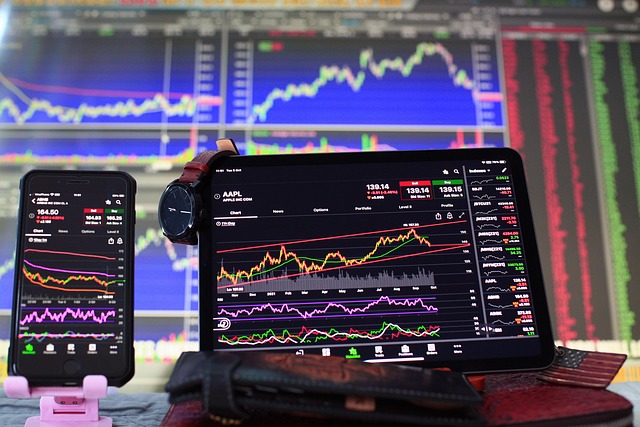TradingView Nasdaq 100 E Mini Futures: 2025 Strategy Guide
Author: Jameson Richman Expert
Published On: 2025-11-07
Prepared by Jameson Richman and our team of experts with over a decade of experience in cryptocurrency and digital asset analysis. Learn more about us.
TradingView Nasdaq 100 E Mini futures are a popular instrument for active traders seeking exposure to the Nasdaq-100 index with high leverage and tight intraday movement. This guide explains how to use TradingView to analyze and trade E-mini NASDAQ-100 (NQ) futures in 2025, covering chart setup, indicators, strategy ideas, risk management, contract specifics, and practical step-by-step workflows you can apply today.

Why trade Nasdaq 100 E-mini futures on TradingView?
Trading the Nasdaq 100 E-mini futures (ticker: NQ on CME) offers access to large-cap U.S. technology and growth stocks in a single, liquid contract. TradingView provides advanced charting, a vast public library of indicators and strategies, real-time data (with subscriptions or broker feeds), and a Python/Pine ecosystem for automated signals and backtesting. The combination of NQ liquidity and TradingView’s tools makes it an excellent platform for both discretionary and systematic traders.
Quick facts and authoritative references
- Underlying: NASDAQ-100 Index (top non-financial companies listed on Nasdaq) — see the official index overview on Wikipedia: NASDAQ-100.
- Exchange & contract specs: CME Group lists E-mini Nasdaq-100 futures details and trading hours — see the CME contract page for the latest official specs: CME Group NASDAQ-100 futures.
- Common symbols: NQ (E-mini), MNQ (Micro E-mini) — Micro E-mini offers smaller notional size for account flexibility.
Understanding the instrument: contract structure and key specs
Before trading, understand contract economics and how price moves translate to profit/loss.
- Contract multiplier: The E-mini NASDAQ-100 futures contract multiplier is $20 per index point. For Micro E-mini (MNQ), the multiplier is $2 per index point (one-tenth the size).
- Tick size: Tick is 0.25 index points = $5 per contract for E-mini (NQ). Micro E-mini tick value is $0.50 per contract.
- Trading hours: CME Globex provides nearly 24-hour trading. Exact sessions and holiday schedules change — consult the CME page for current hours.
- Margin & leverage: Margin requirements vary by broker and market volatility; initial margin is set by exchanges and adjusted by brokers. Always check your broker or the CME for current required margins.
Note: contract specs and margins can change — always verify on the official CME Group page before trading.
Setting up TradingView for NQ trading (step-by-step)
Use this checklist to create a TradingView workspace optimized for Nasdaq 100 E-mini futures analysis.
- Subscribe to real-time data if needed — depending on your broker and subscription plan, you may need a CME or futures data feed for real-time NQ prices.
- Create a dedicated layout: Add multiple saved chart layouts for timeframes: 1-min, 5-min, 15-min, 1-hour, 4-hour, and daily.
- Add indicators: Keep a core indicator set for structure and confluence (suggestion below).
- Configure alerts: Price alerts, indicator cross alerts, and Pine-script strategy alerts for order triggers or risk events.
- Set up a watchlist: Include NQ, MNQ, top constituents (AAPL, MSFT, NVDA), and correlated instruments like S&P 500 futures (ES), VIX, and major tech ETFs.
- Load templates & Pine scripts: Use or customize community scripts for volume profile, session VWAP, and order flow overlays.
Recommended TradingView indicators and why
- VWAP (Volume Weighted Average Price): Key intraday anchor used by institutions — great for mean-reversion and trend confirmations.
- EMA Ribbon (8/21/50/200): Helps identify short-, mid-, and long-term trend alignment and moving-average confluence zones.
- RSI (14) and Stochastic: Momentum and overbought/oversold conditions for mean-reversion or divergence setups.
- Volume Profile / Visible Range: Identify high-volume nodes (HVNs) and low-volume nodes (LVNs) for value areas and breakout targets.
- ATR (Average True Range): Volatility sizing for stop placement and profit targets (e.g., 1.5–2x ATR for stop distance).
- Market Structure / Order Blocks script: Helps identify institutional footprints and supply-demand zones.

Top TradingView strategies for Nasdaq 100 E-mini (with examples)
Below are proven approaches adapted for NQ. Always backtest and forward-test on TradingView before trading live.
1. Trend-following breakout (favorable in strong directional markets)
Idea: Capture impulsive moves after consolidation breaks with confirmation from volume and trend indicators.
- Timeframes: 5-min for entries, 15-min for structure, 1-hour for direction.
- Setup: Consolidation near VWAP or MA support; breakout candle closes above the range with >1.5x average volume.
- Confirmation: EMA ribbon aligned (short EMAs above long EMAs) and RSI not yet in extreme overbought.
- Entry: Market or limit on breakout retest of the breakout level.
- Stop: Below the breakout low or 1–1.5x ATR from entry.
- Target: 1.5–3x risk or next weekly structure level; scale out partial positions at 1x risk.
2. VWAP mean-reversion (intraday institutional strategy)
Idea: Institutions use VWAP to measure fair value. Price often reverts to VWAP after extended moves intraday.
- Timeframe: 1- to 15-min charts.
- Setup: Price extends >2% from VWAP intraday with declining momentum and volume spike followed by divergence on RSI.
- Entry: Fade the extreme, targeting VWAP; enter on a 1-3 candle confirmation back toward VWAP.
- Stop: Beyond recent swing extreme or 1.5x ATR.
- Target: VWAP or value area; tight R:R often 1:1.5 because mean-reversion has higher win rates but smaller moves.
3. Pullback to moving average in trending markets
Idea: In an established trend, pullbacks to EMA 21/34 provide low-risk entries.
- Timeframe: 5-min/15-min entries, 1-hour trend view.
- Setup: Price above EMA 50 and 200 and pulls back to EMA 21/34 with reduced selling volume and bullish divergence.
- Entry: On a rejection candle or bullish engulfing at the EMA zone.
- Stop: Below the pullback swing low or a multiple of ATR.
- Target: Recent highs or 2–3x risk for trend continuation.
4. Range fade using Volume Profile
Idea: When NQ is range-bound, fade moves away from POC (Point of Control) into value areas.
- Timeframe: 15-min to 1-hour.
- Setup: Clear horizontal range, POC identified via Visible Range Volume Profile, and price tests range edges on low momentum.
- Entry: Limit orders near high-volume node or range boundary; aggressive traders use market orders on reversal confirmation.
- Stop: Tight, just beyond range edge, to control velocity risk.
- Target: POC or mid-range with high frequency, small R:R.
Pine Script & automation: practical TradingView automation tips
TradingView’s Pine Script lets you create custom indicators and strategies for backtesting and alerts. Useful automations for NQ include:
- Alert scripts that push signals to Telegram or email via webhooks for order execution or manual confirmation.
- Strategy scripts using realistic commission and slippage settings for accurate performance metrics.
- Heatmaps and correlation scripts to watch NVDA, AAPL, and other Nasdaq heavyweights that drive NQ moves.
Example: build a Pine Script that alerts when price crosses VWAP and EMA13 confluence with volume spike >1.5x average. Use Strategy Tester to run over at least 6–12 months and record drawdowns, win rate, and expectancy.
Risk management & position sizing for E-mini NQ
Risk management for leveraged futures is critical. Here are practical rules used by professional traders:
- Risk per trade: 0.25%–1.0% of account equity per trade (adjust for experience and volatility).
- Maximum daily drawdown: Define a strict daily limit (e.g., 2%–4%) — stop trading for the day if hit.
- Use ATR for stop sizing: Multiply ATR(14) by 1.25–2.5 for stop distances; convert to dollar value using contract tick size.
- Position sizing calculation: Contracts = (Account Risk $) / (Stop Distance in $ per contract).
- Correlations: Avoid overexposing to the same directional risk across correlated instruments (e.g., holding NQ and large position in NVDA options).
- Margin stress testing: Monitor maintenance margin and simulate gap risk during earnings or macro events.

Sample trade walkthrough (realistic scenario)
Example: You have a $50,000 account and decide to risk 0.5% ($250) on a long NQ scalp.
- Identify a bullish trend on the 1-hour chart; price pulls back to EMA21 on the 5-min chart with VWAP support.
- ATR(14) on 5-min is 12.5 index points → 12.5 * $20 = $250 per contract ATR. For more realistic short-term ATR assume smaller; adjust decimals as needed.
- Choose a 6-point stop (6 * $20 = $120 risk per contract). To risk $250, you can trade 2 contracts (2 * $120 = $240 risk).
- Place entry on confirmation and set stop-loss 6 points below entry, target 12–18 points depending on structure for a 1:2 or 1:3 R:R.
Note: convert index points into dollar amounts carefully and confirm contract multipliers for micro vs. standard E-mini contracts before sizing.
Common mistakes and how to avoid them
- Ignoring session behavior: NQ sees different liquidity and volatility during the US open vs. Asian/European sessions. Trade smaller size outside core hours.
- Overleveraging: High leverage multiplies both gains and losses — constrain position size based on account risk tolerances.
- Not adapting to news/earnings: Tech earnings and macro events can gap futures — reduce exposure around major events.
- Overfitting strategies: Avoid curve-fitting indicator parameters to historical data; prefer robust out-of-sample testing and walk-forward validation.
Using external resources and continuing education
Learning is ongoing. Use reputable resources and community tools to refine your edge:
- Official reference: CME Group contract specs and news for official announcements — CME Group.
- Index background: The NASDAQ-100 overview on Wikipedia provides context on composition.
- Platform tutorials: TradingView Help Center and community Pine Script library for practical code samples.

Additional tools, brokers and sign-ups (practical links)
If you're ready to trade or demo, some popular platforms supporting futures or derivatives include margin-enabled exchanges and derivatives brokers. Below are registration links and resources you can use (use these only after reviewing terms and requirements in your jurisdiction):
- Register at Binance — broad crypto and derivatives platform (check CME-linked derivatives offerings in your region).
- Sign up at MEXC for derivatives access and futures markets.
- Open a Bitget account for margin and futures trading.
- Join Bybit — another derivatives-focused platform with futures markets.
Further reading and related articles
These curated posts provide complementary perspectives on trading technology, tools, and market picks. They are useful if you're building a broader trading workflow or exploring algorithmic assistance:
- XRP Price Projections 2025 — scenarios, drivers, and strategy — useful if you trade cross-market correlations and crypto-related flows.
- Trader App Reviews & Best Picks — for mobile execution and trade management tools.
- Top Altcoins to Buy Now — picks and trading strategy — perspective on altcoin impacts and liquidity cycles (relevant if you also trade correlated crypto futures).
- Which Trading Robot is Best? — comparing automation options for different strategies, helpful for Pine Script to trading bot transitions.
- Is eToro Good for Crypto? Practical Review — general platform review useful for retail traders diversifying across assets.
Backtesting and performance evaluation on TradingView
To reliably test strategies for NQ:
- Use TradingView’s Strategy Tester with realistic assumptions: commissions, slippage, and order execution rules.
- Backtest across multiple market regimes (bull, bear, sideways) to evaluate robustness.
- Measure metrics: expectancy, profit factor, max drawdown, Sharpe ratio, and win rate.
- Walk-forward test by dividing data into training and out-of-sample periods.
- Paper trade in a live session or use a small real account to validate live performance under slippage and latency conditions.

Market microstructure tips for intraday NQ traders
- Watch order flow and depth if your broker exposes DOM/Level II — large resting orders can act as magnets or rejection zones.
- Observe liquidity at the open and close; the first 30 minutes often see higher volatility and slippage.
- Be cautious around macro releases (FOMC, payrolls) and notable earnings from tech giants — these can cause rapid gapping moves that invalidate intraday strategies.
Final checklist before placing a live NQ trade
- Confirm chart timeframe matches strategy and top-level trend (1-hour/4-hour).
- Check news calendar for scheduled macro events or major earnings.
- Verify margin and available buying power with your broker.
- Set stop-loss and target on the platform before executing the order.
- Enter contract quantity based on pre-calculated position size and risk rules.
- Log the trade in a trading journal with screenshots and rationale for post-trade review.
Conclusion: combining TradingView tools with disciplined execution
TradingView provides a professional-grade environment to analyze and trade tradingview nasdaq 100 e mini futures, but success depends on a disciplined edge: robust strategy design, rigorous risk management, realistic backtesting, and continuous adaptation. Use the templates, indicators, and workflow steps in this guide to build a consistent process. Start with small sizes (consider Micro E-mini MNQ if new), validate strategies, and scale only after repeatable profitability and acceptable drawdown behavior.
For traders expanding beyond equities futures into crypto and derivatives, the linked resources above discuss trading platforms, altcoin ideas, trading robots, and strategy reviews that can help broaden your toolkit. Always verify instrument specifics on official exchange sites before trading and consult licensed financial advice if needed.
Risk reminder: Futures trading involves substantial risk and is not suitable for every investor. Losses can exceed deposits when using leverage. Always trade with capital you can afford to lose and use risk controls.